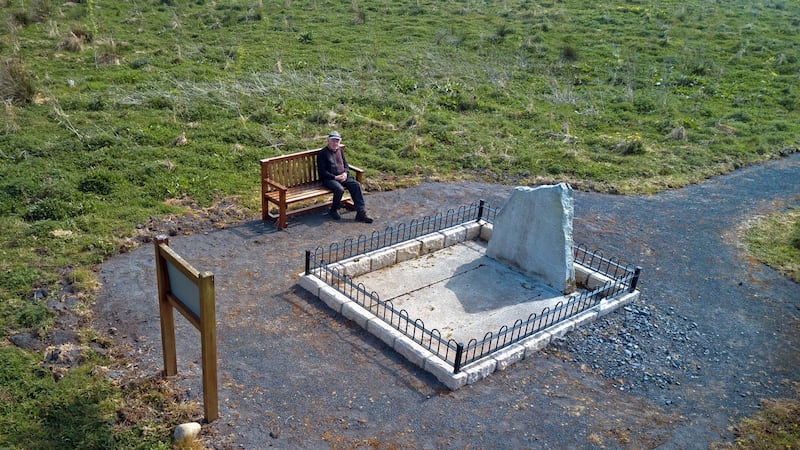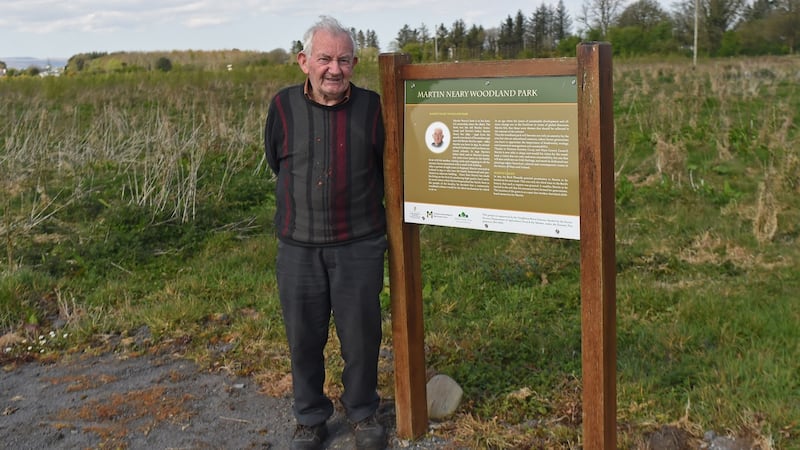There is an old marble headstone half buried among the dandelions and long grass behind Martin Neary’s home in the townland of Madogue, Co Mayo. I am making my way to his door when I spot it. Despite the torrential rain, I am startled into stopping, unsure as to what I am looking at. Is this a grave in a back garden?
The names carved on to the headstone are family names; Martin and Elizabeth Neary. The dates are 1949 and 1980.
It is not every day I show up to interview someone and have to pass an abandoned gravestone to access their house. For a second, I wonder if I am hallucinating because, as it happens, the reason I am here to interview Martin Neary is that he recently received permission to be buried on his land. He is apparently one of only three people in Ireland who have received this unusual permission. I had been thinking of burials on the drive from Dublin, and now I am looking at a headstone where I did not expect to see a headstone. But it's not his: Martin Neary has appeared at the door, waving to me.
Electricity came in 1954, or 1955. I remember the oil lamps. Certain local houses would sell oil, and certain shops in the countryside would sell it
Inside, beside a lively turf fire, I ask gingerly about the headstone in the long grass.
"Ah, that was the old one," he says. It was the original headstone that marked his parents' grave in Bushfield Cemetery in nearby Charlestown. He has since commissioned a new one. "The sculptor, or whoever he was, dropped it there. It's there maybe a year. The council reckon that they might build a wall. There is a pile of stones out there and it would be a way of doing something with them. And they said they might put that headstone into the wall somehow."
“It’s kind of unusual to have two headstones, isn’t it?” I venture.
“’Tis, I suppose,” Neary replies, laughing. “It’s too heavy to move myself. I would need help. So there it lies.”
Bequeathed
Martin Neary is 78, a retired farmer, who reclaimed over time some 30 of the 37 acres that his land is composed of. His father died when he was a child, and his only sibling died aged a few months. His mother died 42 years ago. He never married, and does not have children, or close kin. He has bequeathed his land – on which he will be buried – for public use. The Martin Neary Woodland Park has been planted with a variety of native broadleaf trees by the local council and the Western Forestry Co-op. These many trees include alder, rowan, hazel, birch and oak.
“We farmed seven acres when I was a child. We had a few cattle,” he says. “Electricity came in 1954, or 1955. I remember the oil lamps. Certain local houses would sell oil, and certain shops in the countryside would sell it.” His mother cooked on an open fire. He walked to school. “When I was going to school, there were 19 children going out of this village, and now I don’t know if there is a single child going to the national school.”

Neary left school at 13, after doing three months at secondary school. He didn't see the point of staying on. "There was no work, you went to England, that was it. I farmed the land for a couple of years after leaving school, and then I went to England, to Shropshire, to work in the sugar factory. I only went for the winter, September to February. I went over there for eight years. You made a bit of money and you could do something with the land when you came back, and you could increase your stock of cows. I would have liked to stay in England, but I was attached to the land and then I would have had to come home to look after the old people [his mother and an aunt]."
Ringtone
Neary is a little hard of hearing now, which means he has the ringtone on his phone turned up to the maximum. When it rings, as it frequently does during our conversation, it is the unignorable sound of a blaring siren. I have only ever previously heard the sound of air raid sirens in movies, but during one afternoon this week in rural Mayo, I heard it five times.
Well, when I die, I won't be going to Heaven or Hell. I don't believe in any of that. I'll have to leave the land behind, and I thought I was as well to stay with it
The Woodland Park in his name was officially opened only a fortnight ago, which is why his phone is now ringing so often. After one call he says: “People are saying I did something good, by leaving the land, and getting it planted with woodland. But I was doing it to please myself. I wanted somebody to look after the place after I would go. I reclaimed all the land, it kind of took a lifetime to do that. I wound up with 20 Limousin cows, and then the bypass came, and they took four aces of land, and then I was old enough to retire.”
Why did he want to be buried on his land?
“Well, when I die, I won’t be going to Heaven or Hell. I don’t believe in any of that. I’ll have to leave the land behind, and I thought I was as well to stay with it.”
Several years ago, Neary engaged the services of an architect, so that he could get planning permission to be buried on his own land. Permission was turned down by the council, but he appealed to An Bord Pleanála, which eventually granted it. “I wasn’t expecting to get permission, but by God, one day they gave permission. They said if I was buried on the land, there would be less waste from me than from an ordinary house, is how they put it.”
Does he know who the other two people in Ireland were who also got permission to be buried on their private land? He knows who one of them was.
"A woman in Donegal [Judith Hoad] buried her husband in the garden. I rang her one time. She was into herbs and all that kind of thing. She wanted to know what kind of coffin I wanted. I wasn't thinking of coffins at the time. She would be into wicker coffins. She mentioned who was producing them in case I was interested. So her husband was one. I don't know who the other one was."
Remote
Madogue is quite remote, a townland located some distance off the Charlestown-Swinford road. To get to Neary’s house, I have had to drive up a long avenue, which has a wide spine of grass in the middle.
Does he ever get lonely?
"If I have something to read, I never feel lonely. I love to read," he says. There are stacks of books piled on the dusty mantelpiece. Agatha Christie's Poirot. The Works of Lord Byron. Frank McCourt's 'Tis. He has just finished John McGahern's Memoir. "I bought two books there lately in a car boot sale. One was about Oscar Wilde and the other was by, what's his name? That fella who went to France? Beckett! Jesus Christ, that was a hard one to read. I kept turning the pages, but nothing was happening. I was waiting for something to happen."

Over the years, Neary has had a succession of sheepdog collies. There's a portrait of one of them on the wall behind us, Salman. "After Salman Rushdie. The man who painted it was reading a book by Salman Rushdie at the time, so I thought I'd call the dog after him." Other collies were Fidel ("that was after Fidel Castro"), Beethoven and Conor Cruise O'Brien. "But I wasn't too pleased with O'Brien's later activities in politics. The dog was all right, but not the man."
His most recent dog was Van Gogh, who died just before Christmas. “The postman hit him. He didn’t mean to, though.”
He’s currently looking for a new dog, but not a pup this time. “I’d like an older dog. I wouldn’t be able to keep up with a pup.”
The fire has died down, and the rain has ceased. “Would you like to see my grave?” he asks eagerly, which again, is a new one on me, despite more than two decades of reporting.
Picnic tables
We go out the back door and pass by the old headstone, whose modern new twin is now in Bushfield Cemetery. The hundreds, if not thousands, of trees that have been planted in the woodlands he is leaving to the public were planted three years ago. They are thriving. There are some benches and picnic tables scattered around the woodland, as well as some noticeboards explaining the provenance of the Martin Neary Woodland Park. (It’s a shame that someone from the Department of Agriculture, Food and the Marine, whose name appears on the bottom of these boards, did not take the care to proof-read the text before immortalising it for the public. The public can, apparently, enjoy “picnic area’s” in the park.)
The two of us walk through rows of alders and hazels, and through a small wooden gate to the plot where, in due course, Neary will be interred in the land his family farmed for some 170 years. There is a large, as-yet-uncarved headstone at one end. He regards it with quiet satisfaction.
What does he do next, I ask.
“I was thinking I could have a wake every year. There is great fun at a wake, but the person who is dead cannot enjoy it at all. But I could have one every year,” he chuckles.
I drive away thinking that the fella who went to France – Samuel Beckett – would approve of these plans for multiple "wakes".











